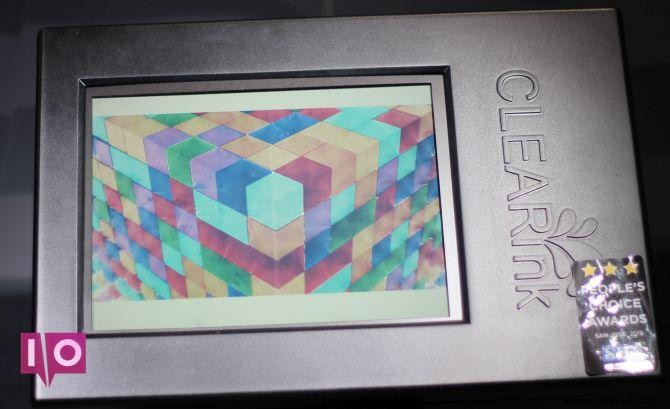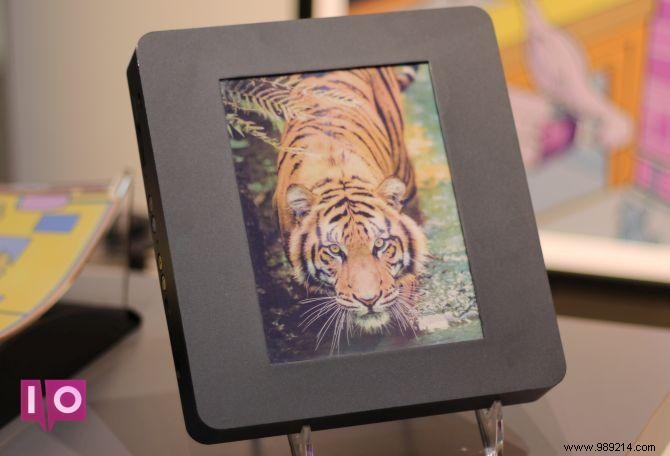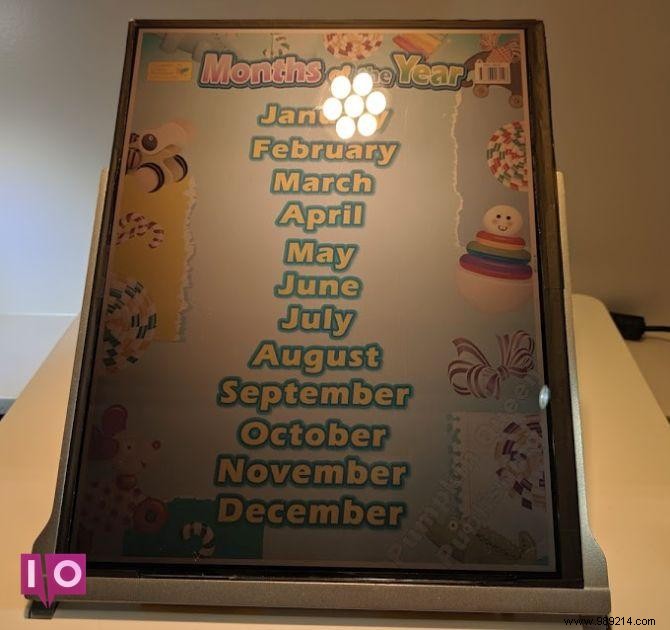Color e-reader displays, like E Ink's Advanced Color e-Paper (ACeP), Tianma's Color LCD, and ClearInk, could revolutionize e-readers in 2020 and 2021. I took a first look hands-on with these technologies and analyzed their potential to reach mainstream readers, like Amazon's Kindle, in 2020 and 2021.
Contents1. ClearInk's color eReaders in 2020?ClearInk does color and video for less moneyProblems:ghosting, color accuracy and waveforms2. Color E-Paper E-Paper ACeP 2nd generation in 2020?3. Color filter matrices for e-readers?4. Reflective color LCD from Tianma5. Hisense Color EreaderKindle Color phone in 2020 or 2021?In short:if you're looking for a color e-reader, the end of 2020 is the first that could arrive. But why the wait?
New playback screen technologies don't come out very often. Most new products are incremental enhancements that are released on a three-year cycle.
Revolutionary technological leaps are rare. So rare that when they reach devices, it's a big deal. Sri Peruvemba, former head of marketing at ClearInk Displays, thinks 2020 or 2021 could be such a year.
ClearInk first announced its technology in 2016, but has since secured partners such as Lenovo and display-making giant Tianma. Unlike the majority of e-paper displays, ClearInk manages to do some things its competitors can't:cost-effective color video, without the need for backlighting.
E Ink's Triton was the last color e-paper technology to hit readers, but it never had a chance to reach Amazon's Kindle. The Triton panel cost a fortune and suffered from low contrast ratio, high cost and slow refresh rates. In other words, it didn't look good and couldn't play the video. That's why it didn't last long.
AdvertisementClearInk, on the other hand, displays color at around 4096 colors or high color. Which means it is less dynamic than LCD and OLED panels. Its 33Hz video refresh rate (equivalent to broadcast TV or YouTube) enables full-motion video. Here's an example I shot at Display Week 2019:
The video and great clarity of ClearInk depends on the type of ink it uses. ClearInk and E Ink create images using electrophoresis, however, there is a big difference between the two. E Ink uses two pigments. The added overhead of dual-pigment processing results in slower refresh rates and jerky video.
ClearInk differs in that it uses a single smaller pigment to create blacks and whites. The ink used in ClearInk, co-developed with Merck, is sharper and clearer than E Ink panels. According to Peruvemba:
The end result:higher contrast, lower power consumption, higher resolution, and even color video, when combined with a color layer.
AdvertisementWhile the video variant of ClearInk consumes more power than E Ink, its power consumption compared to LCD is around 80-90% less. Additionally, it can display moving videos with a refresh rate of around 33Hz – a bit jerky, but good enough.
Unfortunately, I have nothing new to report on ClearInk as they did not attend Display Week 2020 this year.
ClearInk is not a perfect technology. On the other hand, it suffers from image retention issues, or ghosting, where certain parts of the screen do not refresh. You can see a small amount of ghosts here:

The ClearInk engineering team explained that the retention was an early prototype issue rather than a problem with the technology.
Additionally, the ClearInk panels have the same color accuracy as the Triton 2, which, while good enough for textbooks and comics, isn't good enough for professional purposes.
And finally, like E Ink, ClearInk panels require special software and hardware to create and draw images on its screen. In other words, the hardware-level infrastructure and software techniques used in LCD technology are not fully compatible with ClearInk panels. ClearInk screens cannot simply be dropped into a computer without writing special software.
However, Peruvemba mentioned that they are working on panels which are integrated solutions for LCD screens. This means that if successful, manufacturers could simply replace an LCD screen with a ClearInk panel at no additional cost.
Advertisement

During display week of August 2, 2020, E Ink Holdings Inc. announced its 2nd Generation Advanced Color ePaper Display (ACeP). Onyx has scheduled the Color Boox Poke, which Onyx's product page says uses ACeP version 2, for release on August 10th. First orders will cost around $260, almost $100 more than its Poke 2 player. Unfortunately, videos of the Poke Color show it using a Kaleido E Ink display, not ACeP version 2.
You can see the video demonstration of E Ink on ACeP verison 2 below:
https://www.youtube.com/watch?v=JT-5WJWs_mwUnlike older models, the section version of ACeP renders black-and-white E Ink pages extremely quickly – a huge improvement over its first-generation ACeP panel. However, it still seems to suffer from some stutter for rendering color images.
Even so, its color saturation is phenomenal for a reflective panel.
Unlike E Ink and other technologies that use one or two colored oils, black or white, ACeP uses four different colored pigments. The added complexity is what causes the slower refresh rates.
In order to refresh E Ink screens, many readers use their system-on-chip (SoC) for fast page turns. Screen technology alone is only half of the equation for building a better eReader.
Unfortunately, early ACeP panels can cost a lot more than black and white E-ink. Digital signage products that use ACeP panels are extremely expensive. If that's any indication of what a consumer e-reader would cost, it may remain unaffordable well beyond 2021. However, if a color-reflective display ever makes its way into a Kindle, it's likely to be ACeP due to its high color saturation. colors, which makes it perfect for reading manuals and comics.
Another type of e-paper technology is the Color Filter Array (CFA). A CFA places a thin layer of colored liquid crystal filters on another panel, usually an electrophoretic panel, like E Ink. The multiple layers together create a color display, albeit at a reduced resolution compared to a standard E Ink panel.
Today's best CFA panels have a color depth of around 4000 colors, or High Color, and would be significantly lower in resolution than Carta (because CFA film overlaid on Carta film will reduce its resolution). /P>
However, CFAs are inexpensive to manufacture and easy to add to black-and-white reflective screens. On top of that, E Ink's implementation of a CFA uses plastic instead of glass, making it lighter and more durable, which is perfect for an educational tablet.
If a color e-paper makes its way into a Kindle, chances are it's CFA-based.

Tianma Micro-Electronics is one of the largest display manufacturers in the world. One of their new products is a reflective color LCD screen, known as a project Electric bag (almost certainly a translation error). Like most e-paper technologies, it does not require a backlight, but is compatible with the front lights used in most e-readers.
The panel is aimed at the education market. The panel is available in a 10.5-inch form factor, a common size in the education market.
Unlike E Ink, reflective LCDs can display color and video. But the trade-off is a limited color gamut and low contrast ratio.
For example, the Electric Bag has a contrast ratio of 12:1 and a PPI of 191. It can also only do 11% of the NTSC color gamut, which is about half of its competitors. However, the price is low and they can be installed in almost any device with little effort.
An engineer offered a price similar to an emissive LCD for a 10.5-inch panel. For the education market, which is aimed at children, it is an ideal product to reduce eye strain.
Tianma said that if a manufacturer is interested, the electric bag will be available in 2020.
Hisense is a manufacturer of televisions and display panels. In Asia, it also manufactures smartphones and other consumer electronics. Hisense has made a black and white E Ink phone known as Hisense A5, which costs $220 on AliExpress. This time they released two smartphones with E Ink color panels:Hisense A5C and A5 Pro CC.
The new phones use E Ink's color printing technology known as Kaleido. Kaleido uses a CFA layer with Carta technology from E Ink.
While the A5C suffers from slow screen refreshes common to black and white E-ink, the A5 Pro CC, thanks to its use of a Unisoc T610 processor, can display full video. Even so, both models suffer from limited color depth, ghosting, and relatively low screen resolution.
The big weakness of the Amazon Kindle is that it lacks color; Amazon is unlikely to release a color version in 2020. Which means if you want a color e-reader, the only options will be using CFA panels.
In the first quarter of 2020, only two color e-readers were announced:an unnamed Android device from iFlytek. Unfortunately, iFlytek is currently under US government sanctions for human rights violations.
The iReader C6 can reach the United States via JD.com, according to a report by The Good Reader. It will come with an undetermined version of Android, 1 GB of RAM and 16 GB of storage. Availability begins March 26.
While Amazon hasn't dabbled in color e-paper since 2018, color e-paper displays may give rivals Kobo and Barnes &Noble a competitive edge in the education market. Both companies have expressed interest in color E Ink, potentially to compete with Amazon's educational e-readers aimed at children.